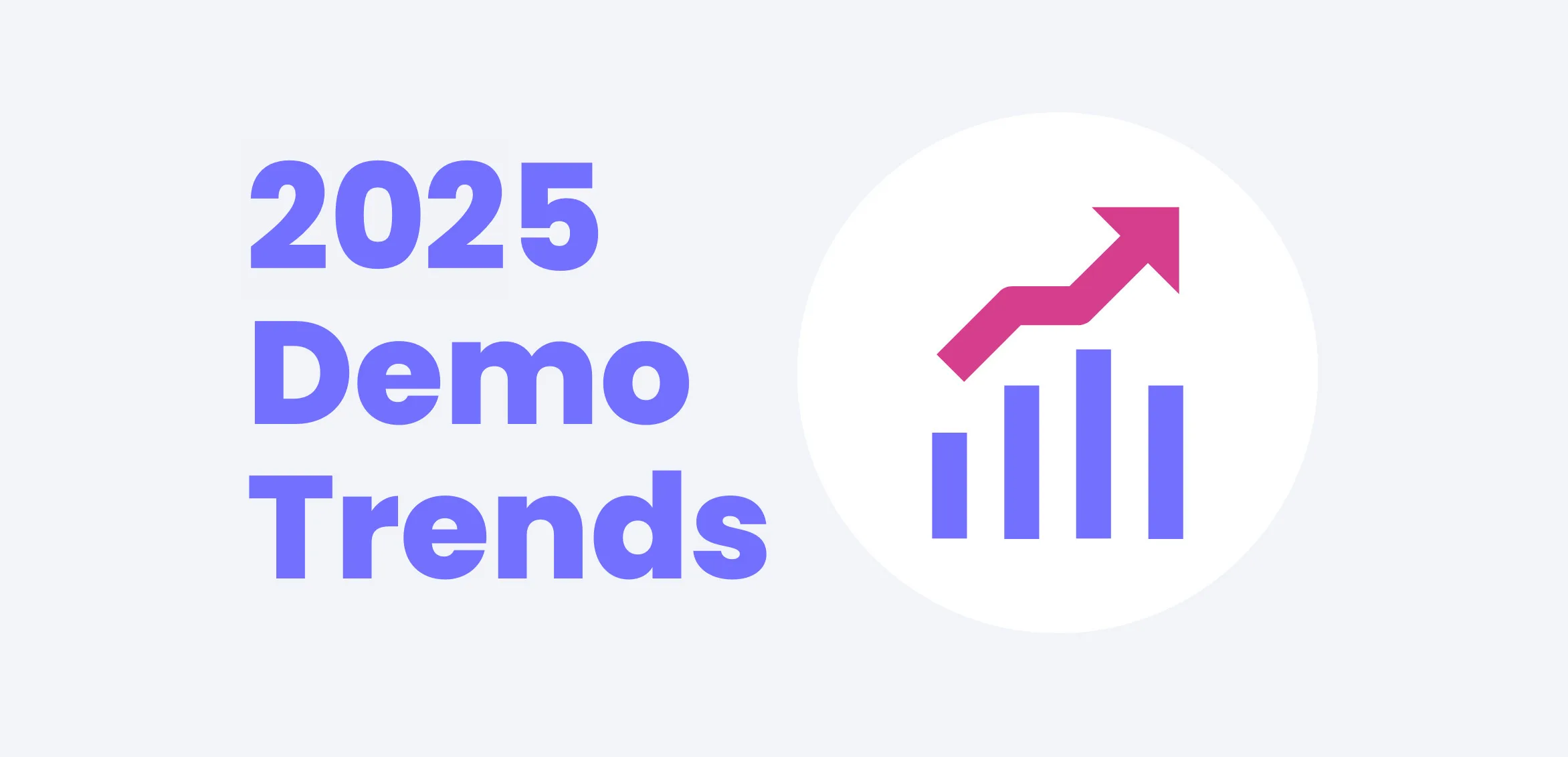Accelerate deals and increase win rates with the leading enterprise AI demo platform.
2025 Product Demo Trends: What You Need to Know

April 23, 2025
Table of Contents
What’s the latest when it comes to product demo trends? It’s all about doing what’s best for your enterprise buyer. While many buyers like to research products independently, a well-informed salesforce has never been more important. In the year ahead, more teams will turn a strategic eye toward demos, building demo programs to expand and scale their go-to-market (GTM) operations.
The top 7 demo trends in 2025
Here are 7 of the top demo trends we’re looking at today, plus strategies to thrive in 2025 and beyond.
1. Demo programs get strategic
Many enterprise sales teams find themselves in a last minute scramble when it comes to delivering product demos to their prospects. According to the 2024 Presales Landscape Report, 39% of SEs reported that AEs are not sharing information from discovery soon enough, and 14% said they aren’t being given adequate notice to prepare for calls with prospects.
To address this challenge, more teams are turning toward demo programs to ensure that their entire GTM organization is prepared to deliver value for prospects through the right demo at the right time. A demo program is a top-down approach to building, centralizing, sharing, and analyzing your demos. It aims to apply organizational structure and governance to the use of demos, helping your presales team amp up their productivity across the board. The ultimate goal is to drive more revenue through the use of scalable, repeatable, and measurable demos.
For example, an enterprise digital business platform was struggling with finding and creating demos for both solution consultants and product marketing. With more than 100 products and 2500 solution consultants, it became unsustainable to deliver a standard 30-minute demo for every prospect. By building a library of reusable demos, GTM team members can search among hundreds of demos of varying lengths and types to customize the content that works best for their customer scenario.
2. The B2B Buying Journey Gets Even More Critical
One of the major trends we saw this year that will only continue to strengthen is that buyers now are much more educated and want to research a lot on their own. If your buyer journey makes it difficult for them to understand your product, you will fall behind.
The data bears the importance of the buyer’s journey out. 52% of companies are still frustrated with the B2B online purchasing experience—and this frustration has caused 53% of them to switch suppliers over the past year.
There’s so much competition in the SaaS world today that you’re likely no longer competing on what your product does alone. Your buyer journey matters so much more to help you stand out to your potential customers.
After all, if you make your sales process opaque, what is being a customer going to feel like? Probably not great. Prospects are shopping accordingly, so you need to adjust your buyer journey. Providing a product tour on your company’s home page or product page will make it much easier for the buyer to visualize your product in their own environment, solving their challenges and pain points.
3. Requests for Product Demos Come Earlier and Earlier
Today’s buyers want to see what you’re selling as soon as possible.
They want to interact, touch, and experience your product right away to evaluate it.
And that’s understandable. But it also means that requests for demos are coming earlier and earlier in the sales process, and we don’t see that slowing down anytime in the next year.
In fact, early-stage product demos are going to be even more critical as a differentiator in the increasingly crowded and competitive SaaS marketplace. Buyers are more educated and more technical these days, and their interest in early product demos reflects that fact.
Your company might not be set up to make those super-early product demos happen—but a demo program can help you eliminate the demo demand bottleneck and enable AEs to handle these first requests for demos on their own.
4. SE Resources Continue to Be In High Demand
Solutions engineers (and pretty much everyone else in the presales field) are highly sought-after and super scarce. And that’s a trend we anticipate continuing to grow rapidly.
There are a few reasons for this shortage.
- SEs have a hard-to-find combination of skills. They combine deep technical expertise with great people skills and great communication, which is pretty tough to find in a single person.
- Presales spends a lot of time building and maintaining demos. According to the 2024 Presales Landscape Report, SEs spend a whopping 21 days per year cleaning and maintaining their demo environment. In addition, many are building demos from scratch for every meeting (whether they’re qualified or not). Given the high demand and short supply of SEs, a well-organized demo library can pay dividends in the weeks, months, and years ahead.
- Buyers are demanding more time with presales resources. Today’s buyers want to talk about technical details and get straightforward answers from an expert. Rather than supporting each and every demo inbound, SEs should be empowered to field these specialized requests.
As SE resources remain scarce, focus on retaining the SEs you already have. Scaling your presales team capacity with a demo creation platform like Reprise can decrease the maintenance burden on SEs, while empowering your entire GTM operation via a comprehensive demo program.
5. The Demand for Interactive Demos Increases
Another area where B2B buyer expectations have gone up is around the sales content you show them.
In 2025, it’s definitely not going to be enough to give them a “demo” that’s just a bunch of slides with screengrabs of your product anymore, or a long and clunky harbor tour video. Those demos are deadly, and your buyers expect more. Enterprise tech companies are highly sophisticated, and having the right demo technology to support a complex product can build buyer trust.
Interactive demo experiences are going to be a must-have in the year ahead. That’s because prospects don’t just want to see that your product exists or what a static page looks like—they want that experience of touching it and experiencing it themselves. And they expect SaaS sellers to deliver it.
Interactive demos are the way to go because they give your potential buyers the freedom to explore the features that matter to them, not only the ones you assume they want to see. And when you give them that freedom (and gather some interesting analytics on what they’re looking at), you gain their trust and also essential data about how prospects explore your product demo too.
6. Your Tech Stack Will Matter More Than Ever
With tighter budgets comes the need for a tighter tech stack. The average enterprise company in 2023 had a staggering 473 SaaS apps—and few employees regularly use the apps available to them.
Clearly, there’s some room for pruning here. Focusing on tech that can be used across multiple departments instead of for just one narrow purpose can help.
For demo purposes, buying access to a platform that only your SEs and demo engineers can use, for example, isn’t going to give you the biggest return because its scope is so limited. Instead, try a demo creation platform like Reprise that the entire GTM organization can use, expanding the potential to create demos throughout the buyer journey.
For example, a prospective customer might view a product tour on your website, request a live demo, and then have to report back to a buying committee. Leveraging an interactive demo as a leave-behind can be a powerful way to convince committee members of your product’s value asynchronously.
“Sometimes we get one shot with a demo, and following up with the leave behind is a nice way to say, ‘Here’s everything we talked about – you don’t have to read this four-page .pdf, you can look at the product yourself. Play around with it, be interactive, and we can guide you through what you just saw.’ That’s been really nice as a better leave-behind to help our customers make informed decisions.” –
7. Budgets Will Keep Tightening
With IT budget growth slowing down,, your marketing efforts will need to be much more effective at increasing conversions, not just users and traffic.
This trend is a big change from how SaaS companies have operated in the past couple of years. VCs and investors that were investing ingrowth at all costs have turned their focus to profitable growth.
Demos play a huge part in driving profitability because when used strategically they can help you increase your free trial and freemium conversion rates.
Retention rates are also going to become an increasingly critical measure of success. If you’re running through huge rates of marketing spend to acquire customers but failing to hold onto them, that spells trouble for your company’s future.
Aligning product, marketing, and sales so customers get exactly what they paid for and keep seeing value in your solution will help you keep them for the long term. That buyer’s journey we talked about should flow seamlessly into the customer journey, and using your product should be as delightful as buying it.
Leveraging Product Demos to Drive Sales
Predicting the future is hard, but one thing holds true. The importance of product demos is only going to grow in 2025—is your organization ready for that growth? If you’re feeling unprepared, Reprise is here to help you future-proof and scale your SaaS demo creation process.






